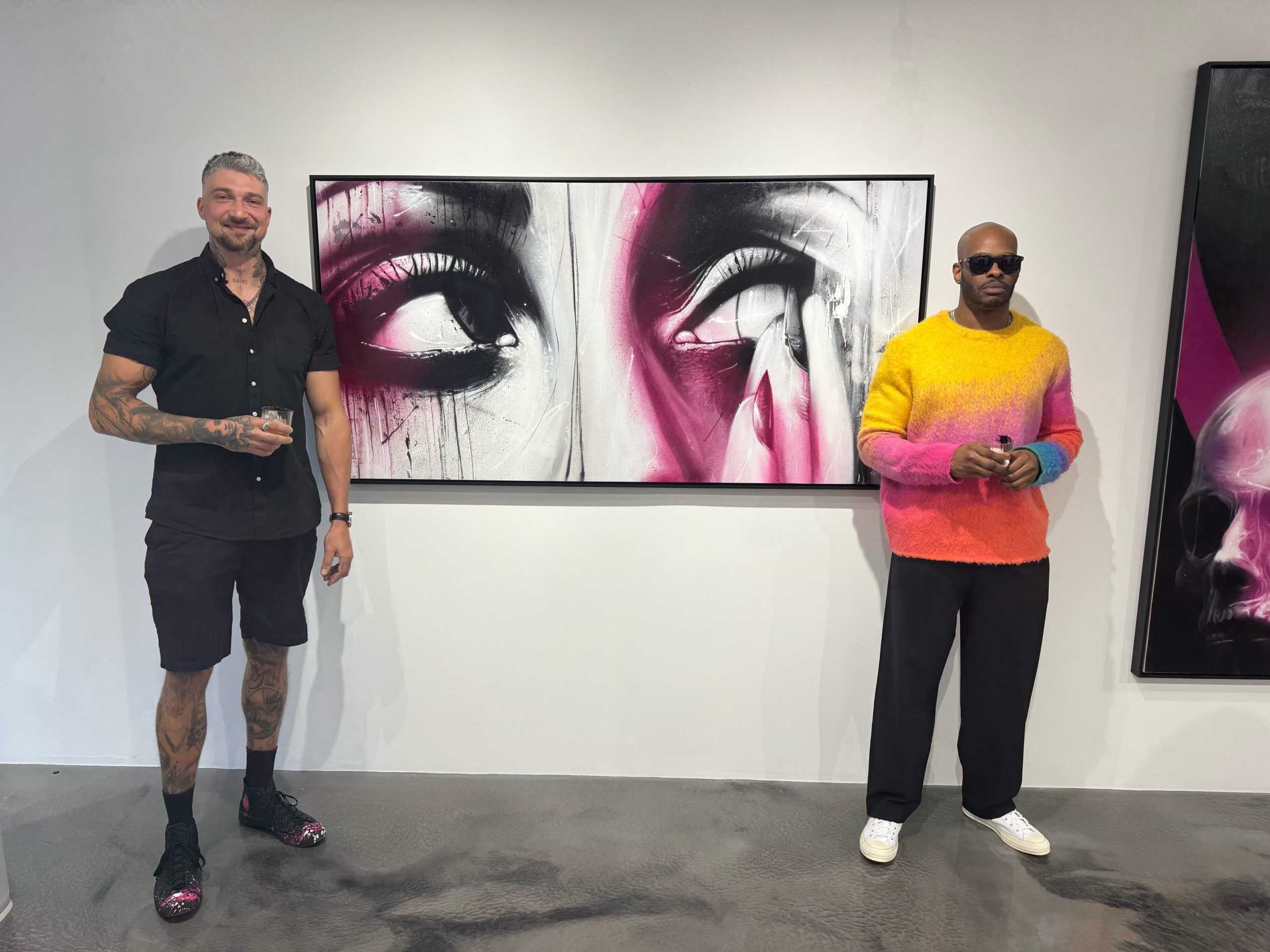on
BY SIMONE J. SMITH
“You have a responsibility as an artist to be a good person.”
“I was sitting in my studio, and I was painting, and the number seven flashed in my mind. I started wondering, why seven? So I messaged my friend Suzie, and told her that I need to use the number seven for my upcoming exhibition. It was April 7th, 7:45…”
There’s something magical about stepping into a world crafted by the imagination of another. It’s more than just seeing. It’s feeling. It’s breathing in creativity.
I had to take a deep breath, my eyes widening at the sight before me. The walls are adorned with vibrant paintings, each one more intricate than the last, each telling its own story. Every spray can, every colour, a testament to the artist’s passion, but it wad not just the art that captivated me.
I noticed the details in the planning, how the lighting perfectly highlighted each piece, casting dramatic shadows and illuminating the smallest details. This was not just an exhibit. This was an experience, a journey through another’s soul…
Here I was again, making my way downtown to another event. With the summer fast approaching, my emails were filling up, and when this one came in, it caught my eye.
“Join us for the exclusive unveiling of “THE CHARIOT” by Toronto-based multimedia artist THE HALF DECENT. Interact with art lovers, industry professionals, and other creatives at an immersive art exhibition you’ll never forget. MAY 10, 2024, 7:00pm – 11:00pm , 214 Avenue Road, Toronto, ON, M5R 2J4,” the email read.
I was instantly artistically aroused, and for good reason. Discovering the work of Mattais (aka, The Half Decent) has revolutionized my understanding and appreciation for creatives who wield the spray can with the same fluidity and mastery as a writer types on a keyboard, or a photographer frames a shot. This artist, whose name resonates with a clandestine allure, transforms urban spaces into vibrant canvases, infusing them with layers of meaning and emotion.
His art, while fully legal, exudes an aura of the forbidden. There’s a sense of raw, unfiltered truth in his pieces, as if the walls themselves are whispering secrets that society often prefers to ignore. His murals are not just visually striking; they are profound commentaries on the human condition, specifically addressing the often overlooked topic of male mental health.
Through bold colors, intricate designs, and poignant symbolism, he sheds light on the internal battles that many men face—struggles with: identity, emotions, and societal expectations. His goal is clear: to spark conversations and bring awareness to the mental health challenges that men endure, often in silence. Each piece is a narrative, a plea for understanding and empathy, urging viewers to look beyond the surface and recognize the depth of these issues.
Of course I wanted to learn even more about this creative genius, so I set up an interview, and he graciously let me into the world of The Half Decent.
“The whole show is about mental health, more specifically men’s mental health,” Mattais tells me. “I have dealt with mental health and depression, and mental health issues run in my family, especially with the men in my family.”
“It is one of the reasons that I choose to use the colour pink for this collection. Pink is feminine colour. The paintings were about embracing what is seen as feminine; emotions. Men usually associate emotions with female energy.”
I was intrigued with his creative process, so I asked him to share a little more about how the images move from his head, onto a canvas.
“I didn’t just want to make pictures, I wanted people to feel; depending on who looks at it, the feeling will change. It is about impact. It is such a trippy feeling to think; I have these images in my head, I put them on the canvas, and people show up to see my work. They don’t just show up, they actually have feedback, and it is usually very positive.”
“What drew you to using spray paint as your medium of expression,” I quieried?
“When I was young, my dad used to draw birds all the time. It was always the same bird. Something about that stuck with me. Most people are artist at heart; we grow up, and sometimes are artist element gets pushed away. This was the case with me. For a long time, my artistic side was pushed aside. I started spray painting, and this kept my artistic side alive. The more I did, the more art I wanted to do. I very quickly started tattooing.”
“What made you choose spray paint as your artistic tool of choice?”
“I am an impatient person, and spray painting is very quick. It is difficult to get small details with spray paint. It is a crazy challenge to get detail. My canvases are practice for what I want to do in the future, which is murals.”
What challenges have you encountered while working with spray paint?
“There is always division between graffiti and street art. When you are in the subculture, graffiti is about a feeling. It is the feeling of painting illegally. I am creating art with spray paint, so sometimes the challenge is within myself. I am doing more legal things, and sometimes I crave going back to illegal graffiti. It is way more respected than doing a legal wall. In some way it is like Gorilla marketing. You have to get more eyes on it. I find ways to continually challenge myself. Can I render the image that I have in my head? what else can I achieve with this medium?”
“How do you see spray paint art evolving in the future? Are there any new techniques or technologies you’re excited to explore?”
“Evolution’s power lies in its relentless adaptability, a trait mirrored in my journey as an artist. Embracing technology, I have transformed my creative process, seamlessly integrating digital tools to enhance and expand my artistic expression. This fusion of tradition and innovation reflects the essence of evolution, propelling my art to new horizons.”
“I am a referenced base artist; I am good at looking at a reference, manipulating the piece. The only thing that matters is the end result. I use AI, and for some people that is controversial. AI is going to play a big part when it comes to the future of art. It will make it easier to convey what you are thinking.”
The Half Decent’s ability to convey such powerful messages through the medium of spray paint is nothing short of remarkable. His work transcends traditional graffiti, positioning it as a legitimate and impactful form of contemporary art. It speaks to the soul, stirring emotions and prompting reflection, much like a poignant novel, or a compelling photograph. His mastery of the spray can elevates his art to a new level, demonstrating that this tool can be as expressive and nuanced as any other in the creative arsenal.
In witnessing his creations, I’ve come to realize the profound potential of street art. It’s a medium that can: reach wide audiences, break down barriers, and provoke thought in ways that few other art forms can. His dedication to highlighting male mental health issues through such a dynamic and accessible platform is both inspiring and transformative, leaving an indelible mark on those who encounter his work.
Stay in the loop with exclusive news, stories, and insights—delivered straight to your inbox. No fluff, just real content that matters. Sign up today!
We, as humans are guaranteed certain things in life: stressors, taxes, bills and death are the first thoughts that pop to mind. It is not uncommon that many people find a hard time dealing with these daily life stressors, and at times will find themselves losing control over their lives. Simone Jennifer Smith’s great passion is using the gifts that have been given to her, to help educate her clients on how to live meaningful lives. The Hear to Help Team consists of powerfully motivated individuals, who like Simone, see that there is a need in this world; a need for real connection. As the founder and Director of Hear 2 Help, Simone leads a team that goes out into the community day to day, servicing families with their educational, legal and mental health needs.Her dedication shows in her Toronto Caribbean newspaper articles, and in her role as a host on the TCN TV Network.













